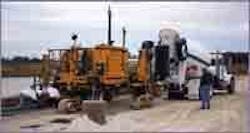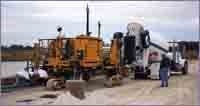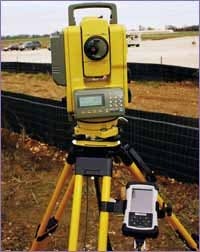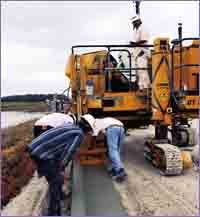No Strings Attached
Crossland Construction Co., established in 1978 and headquartered in Columbus, Kan., has grown from primarily a builder of pre-engineered metal buildings to a multifaceted contractor with 450 employees and branch offices in Oklahoma and Arkansas. That growth, in part, might be attributed to the company's willingness to embrace new technology as a means to enhancing jobsite efficiency, which, ultimately, translates into better serving customers.
To that end, the company last November agreed to use an innovative machine for placing curb-and-gutter at the site of a new Wal-Mart Supercenter in Rogers, Ark. The machine was a GOMACO GT-3600 slipform paver, which had been specially equipped by TSD Integrated Controls to operate under the control of a Local Positioning System. TSD is a joint-venture company created by Sauer-Danfoss, a builder of electro-hydraulic control systems, and Topcon, a manufacturer of positioning-technology products. Ozark Laser and Shoring, a Topcon dealer based in Springfield, Mo., coordinated the demonstration with help from GOMACO.
At the heart of Local Positioning System (LPS) technology is a robotic total station, a surveying instrument with the intelligence to track a machine on the jobsite and to continually determine its XYZ coordinates, that is, its location in three-dimensional space. On the Wal-Mart job, a Topcon GRT-2000 laser-tracking total station was employed.
Key to the total station's function in a Topcon LPS installation is a digital, three-dimensional plan of the worksite (in this instance, the curb-and-gutter design), which is loaded into a small pocket PC that controls the total station. By integrating machine-position and plan information, the Topcon GRT-2000 on the Wal-Mart job could tell the GOMACO GT-3600 exactly how to steer at any point on the project, and exactly how to adjust its three track legs to position its mold properly at that point.
The payoff, of course, was that the machine could operate without string lines, which potentially results in significant cost savings for the contractor who no longer has to install them.
In this Topcon LPS installation, the total station sent steering and elevation information via laser to a machine-mounted receiver, a Topcon LS-2000. The signals received were directed to the machine's G21 CAN-based controller, which subsequently made the required adjustments to track orientation and leg height.
According to TSD's senior engineer, Mike Olson, who was instrumental in developing the software that allows Topcon's LPS package to communicate with the GT-3600's control system, the actual adaptation of the paver was relatively simple. From the software side, he says, loading in the communications programs and doing some basic wiring was a fifteen-minute job.
On the hardware side, the GT-3600 was first fitted with a two-piece mast, which was attached to a central mounting point on the paver. The laser receiver was then mounted at the top of the mast and hardwired into the system. An additional component on the mast was a "longitudinal" slope sensor, which substitutes for the machine's rear grade string-line sensor and complements the GT-3600's standard cross-slope sensor. Setting the longitudinal sensor and telling the system the distance between receiver and mold completed the modification. On future installations, says Olson, a monitor with a visual display of the worksite may be added to enhance operator orientation.
So, what did Crossland Construction think of this system that allowed pouring curb-and-gutter without its crews having to set string lines?
"Performance exceeded our expectations," said the company's Matt O'Brien.



